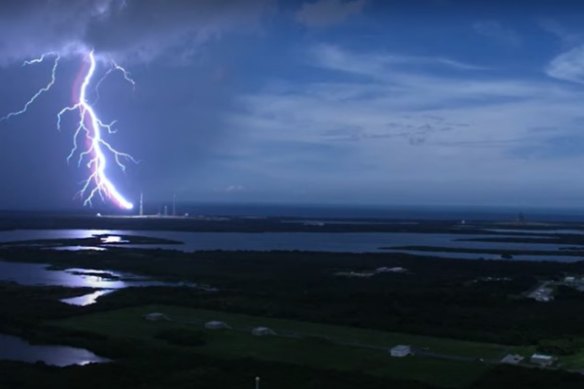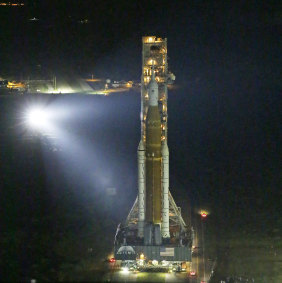
Cape Canaveral, Florida: NASA’s new moon rocket remained on track to blast off on a crucial test flight on Monday US time, despite a series of lightning strikes at the launch pad.
The 98-metre Space Launch System rocket is the most powerful ever built by NASA. It’s poised to send an empty crew capsule into lunar orbit, a half-century after NASA’s Apollo program, which landed 12 astronauts on the moon.

Kennedy Space Centre struck by lightning in 2014.
Artemis is scheduled to launch on Monday at between 10.33pm and Tuesday at 12.33am AEST.
Astronauts could return to the moon in a few years, if this six-week test flight goes well. NASA officials caution, however, that the risks are high and the flight could be cut short.

The NASA Artemis rocket with the Orion spacecraft aboard leaves the Vehicle Assembly Building moving slowly to pad 39B at the Kennedy Space Centre in Cape Canaveral, Florida.Credit:AP
In lieu of astronauts, three test dummies are strapped into the Orion capsule to measure vibration, acceleration and radiation, one of the biggest hazards to humans in deep space. The capsule alone has more than 1000 sensors.
Officials said Sunday that neither the rocket nor capsule suffered any damage during Saturday’s thunderstorm; ground equipment also was unaffected.
Five strikes were confirmed, hitting the 183-metre lightning-protection towers surrounding the rocket at NASA’s Kennedy Space Centre. The strikes weren’t strong enough to warrant major retesting.
“Clearly, the system worked as designed,” said Jeff Spaulding, NASA’s senior test director.









 Add Category
Add Category